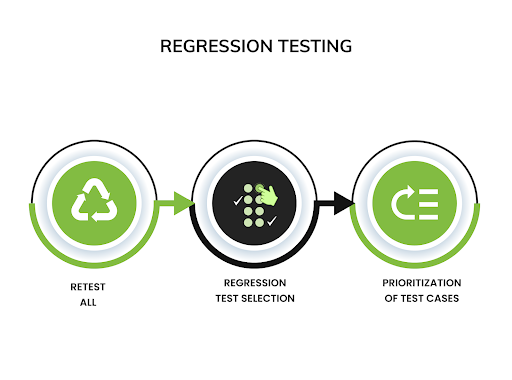Regression testing is a testing type that greatly benefits from automation. Manual regression tests can be time-consuming for QA teams, and there is a risk of missing critical bugs due to the tedious and exhaustive nature of the process. To save time and improve efficiency, automating regression tests is highly recommended. In collaboration with the Zebrunner team, we have delved into regression testing, and compiled a set of valuable tips to enhance your regression testing efforts.
Overview of regression testing
Regression testing is a software testing technique that verifies whether recent changes or updates in an application have introduced new defects or caused existing functionalities to fail. It aims to ensure that modifications or enhancements to the software have not adversely affected previously tested features or functionalities. Regression testing involves re-executing previously conducted test cases to uncover any regression bugs that may have been introduced due to code changes, bug fixes, or system configurations.
The primary goal of regression testing is to identify and catch potential issues early in the development cycle, preventing them from reaching production or end-users. By repeating specific test scenarios, regression testing helps ensure that the software remains stable and functions correctly after modifications, updates, or integrations.
Importance of automation in regression testing
Automating regression testing is generally considered to be better than performing it manually. Regression testing involves the repetitive execution of a predefined set of test cases. Performing this task manually can be time-consuming, and prone to oversight, potentially leading to missed bugs or issues.
Automating this process can save time and effort compared to manual testing, which can be prone to errors and inconsistencies. Automated regression testing also allows for more comprehensive testing and can provide faster feedback on any issues that arise, allowing for quicker resolution.
5 tips on how to enhance the automation of the regression testing
Tip 1. Implement smart test data management
Implementing smart test data management and reporting capabilities enhances the automation of regression testing, resulting in faster, more efficient, and more effective testing processes. With smart test data management, you achieve efficient data usage. Testers gain quick and easy access to the required data sets, eliminating the need to spend time searching for data. This streamlines the testing process and reduces the risk of errors by ensuring the use of accurate data for each test case.
Smart automation reporting provides real-time updates on the status of the testing process. Testers can quickly identify and address issues as they arise, ensuring a smooth and efficient testing process. Real-time reporting reduces the time required for regression testing by enabling prompt issue resolution. Moreover, smart reporting offers detailed insights into the testing process, allowing testers to identify patterns, trends, and areas for improvement. This enables optimization of the testing process, making it more effective and efficient over time.
Tip 2. Prioritize test cases
Test case prioritization helps in identifying the critical test cases that need to be executed early in the regression testing process. By focusing on high-priority test cases, resources such as time and computing power can be allocated effectively, ensuring that the most critical functionalities are thoroughly tested.
In addition, test case prioritization ensures that the most critical functionalities and areas of the software are thoroughly tested. By focusing on high-priority test cases, regression testing can achieve optimal test coverage, targeting the areas that are most likely to be affected by changes or updates.
Tip 3. Establish a robust test environment
A robust test environment minimizes the occurrence of environmental issues or inconsistencies that could lead to false positives or false negatives in test results. It provides a consistent and reliable testing environment, and enhances the accuracy and reliability of the test outcomes, allowing for faster identification and resolution of actual software issues.
Also, a robust test environment facilitates the parallel execution of automated regression tests. It supports the simultaneous execution of multiple test cases or test suites, leveraging the available resources efficiently. Parallel execution significantly reduces the time required to complete regression testing, as multiple tests can be run concurrently.
Tip 4. Develop reliable automated test scripts
Reliable automated test scripts are designed to be maintainable and adaptable. They are built with a modular and reusable approach, making it easier to update and maintain them as the software evolves. This reduces the time and effort needed for test script maintenance, enabling faster adaptability to changes and updates in the application.
Moreover, reliable automated test scripts are optimized for efficiency and speed. They are designed to execute test cases in a streamlined and efficient manner, minimizing unnecessary waiting time or delays. This results in faster test execution during regression testing, reducing the overall time required for completing regression cycles.
Tip 5: Integrate with Continuous integration/Continuous delivery (CI/CD) pipeline
Integration with CI/CD allows regression tests to be automatically triggered as part of the software delivery pipeline. Whenever changes are made to the codebase, the CI/CD system initiates the execution of regression tests. This eliminates the need for manual intervention and ensures that regression tests are performed consistently and promptly.
Also, integration with CI/CD creates a faster feedback loop between development and testing teams. Regression test results are available in real time, providing immediate visibility into the health of the software. This allows for rapid communication and collaboration, enabling the timely resolution of issues and accelerating the regression testing process.





